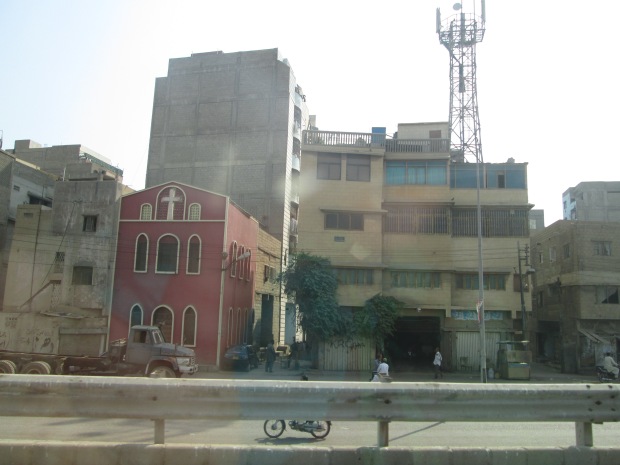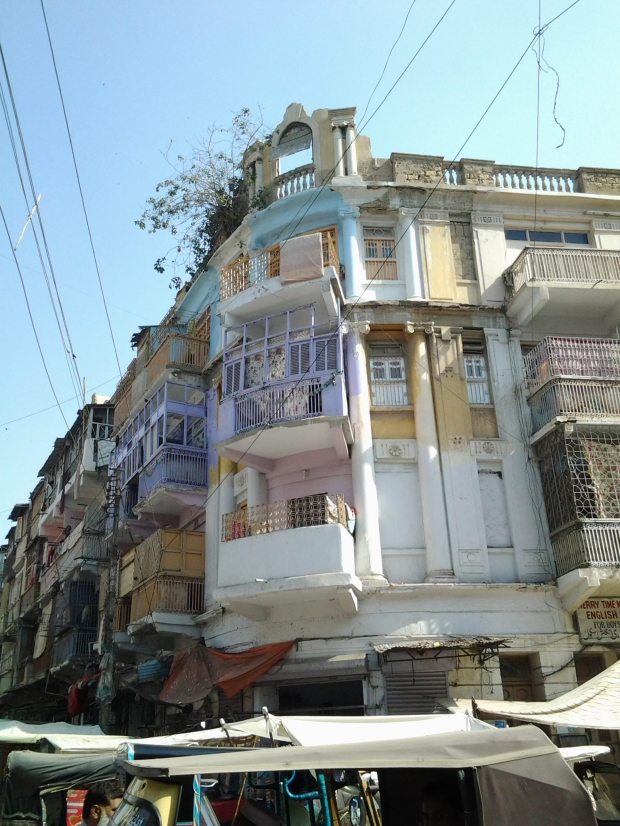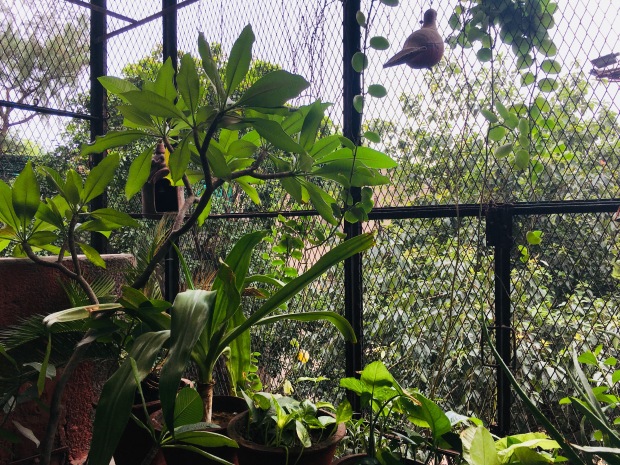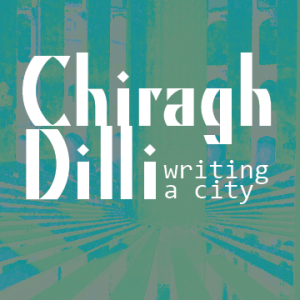ab toh yahaan ke mausam mujhse aisi umeedein rakhte hain
jaise hamesha se main yahin hoon Gangaji aur Jamunaji
Amrohe mein Baan nadi ke paas jo ladka rehta tha
ab woh kahan hai? Main toh wahin hoon Gangaji aur Jamunaji
[Now even the seasons here have such expectations of me
as if I have always been here, Gangaji and Jamunaji
The boy who lived by the Baan river of Amroha
Where is he now? I am there only, Gangaji and Jamunaji]
—Jaun Elia

‘Yeh watan kamzori hai hamari…har saal aana padta hai—this watan is my weakness…I have to come here every year,’ says Mamma Chacha. We are standing in the courtyard of the Katkoi Imambarah in Amroha, it is the tenth day of Muharram and the morning is still, holding within itself all our mythical and real battles and exhaustions. I am thinking of Jaun Elia and Sadequain, two Amroha boys, and wondering how they must have felt living in Karachi, brutally separated from these autumn mornings of Amroha, in this continuous virah from watan and all that it means. Some people yearn for immortal beloveds in the forms of Laila, Dracula or Heer, while Jaun’s Laila was the land, the place and the smells of Amroha.
‘Watan’ literally refers to a place, a country or a land. Yet the word exceeds all the various meanings it holds in language. I have heard people use ‘watan’ in many different ways, like this taxi driver in Delhi who was having a bad day, ‘Main watan wapas jaunga…wahan sab sadkein samajh aa jaati hain—I will go back to my watan…I know the streets there.’ Then I came across the word in Berlin, once again in a cab, as I tried to converse with the driver in my broken German and he in his broken English. Suddenly, on catching a glimpse of me in the rear view mirror, he asked, ‘Watan se hain aap?’ We both began to laugh and quickly shifted to Hindi/Urdu. Even as I had said, ‘ji—yes,’ I never asked him if he meant India or Pakistan.
Interestingly, watan in its everyday usage more often than not refers to where one is not, where one longs to be or what one has left behind or even let go. It is not necessarily the pining for geographical spaces or ideas such as the nation or country—the longing is usually for tiny and particularistic locations…the arms of a lover, the streets of one’s childhood, the corner shops selling adrak-elaichi tea, the smell of winter leaves burning or just ghar ka khana aur ghar ki zabaan, the food and the languages of the home.

The love letters that make this piece were written after a trip to Karachi in 2014. They are about lives that haunt us, languages that inhabit us and cities that flow through us in the form of stories, memories and beloveds. An injunction, a prelude or an epitaph to the journeys that my father and his father didn’t take, these letters are the journeys I wish to undertake through places and beloveds, real and imagined.

Dearest Alif,
I finally reached Karachi today. The flight was shorter than the Delhi–Bombay flight, but they gave us enough biryani to last till the evening.
Rabia picked me from the airport, gleeful that I was wearing my Birkenstocks with anarkali and churidar, and yes, we had a real bodyguard with an AK-47 to escort us around—a Balooch who was over alert and refused to smile. It was all a bit strange, but I felt important and paranoid at the same time.
On the way, when I asked Rabia about Liaquatabad, she seemed shocked that I knew anything about the city. I guess the map of Karachi had been etched on my mind, and speaking of Lalukhet was unavoidable, even if it meant speaking of Karachi’s many ‘others’.
From the car, everything seemed dusty and familiar, just like any other Indian city, except all the political slogans and wall graffiti were in Urdu. For all you know, this could be Rampur, Bareilly, Kanpur, Lucknow or Dehli, as the Karachiwalas call Delhi, though I’m not sure anymore…about languages, walls, cities or beloveds.
Love,
Leela

Dearest Alif Janam,
The mornings here are lovely and familiar…they smell like a misty Delhi November, with winter dew on our feet, what do you guys call it…shabnam? The khansamah Jugnu has laid out tea in the lawns. I keep calling him bhaiyya in my typical Delhi kinship style, and he is amused. Everyone else either calls him by his name or asks him to do tasks very politely. I wonder if it’s some kind of feudal debris left here, or just my over conscientious Delhi middle-class mind, unable to break out of my ‘bhaiyya’ mode with him. The chai is lovely and served with omelette. Everyone has left for work; aunty is at home, and she sleeps in late. She could be a character from one of those novels written on the Muslim elite women of north India, very stylish and very sharp, but continues to declare her love for Salman Khan through the day.
I think of these courtyard houses of Karachi as some kind of patchwork of mofussil households of UP transposed into the montage of this city established by Muhajirs trying hard to replicate a Bareilly or an Amroha in a new geography. But I guess the lines have been drawn, and the courtyard here will never be inhabited as it used to be back in Shamsabad.
Clifton felt like Jor Bagh and Defence Colony in Delhi…here too the frangipani nights and wicker chairs adorned long-leaf tea and conversations about London and New York. Watan was lost to these aangans, and may be new watans were being forged. Interspersed beyond the corners of these aangans lay small markets, much like mini Bhogals, with their kirana shops, tailors, kasais, sabziwallas, halwais and chaiwallas, chattering like they do all over my city, Delhi.
Love,
Leela


Dearest Alif,
Today as I went out for a ride through the Lyari bypass, I realized in how many ways the city is kept apart. The bypass cuts across Lyari’s katchi abadi (what slums are called here) as if a Corbusierian surgery has been conducted on the city. Lyari appears to have been built slowly, incrementally, with different ilaqas for Pathans, Baloochis and different Muhajir communities, based on areas of their origin in India. The driver pointed out the flags of the Pathans and that of the Muhajir Qaumi Movement. He could not understand my excitement though. And, of course, I was not allowed to step out and walk into Lyari.
Everything seems desert like, with the yellow brick used in the katchi abadis. I wonder what they are referring to when they say katchi because the houses seem very sturdy despite the transience of poverty and homelands.
With the night approaching, I wonder how the women from Lyari travel, how they go out to work and what mode of transport they take back home.
My guard and driver drop me off, just in time for a pakka nihari and roti dinner. I guess money makes everything pakka, even the Muhajirs.
Sleep well,
Leela

Aye mere Ishq-e-Majazi,
How are you? You had once said, ‘For me, speaking in English is like going for confession.’ I now know what you meant.
I did not know I knew Urdu till I got to Karachi. Here, ‘shabd’ becomes ‘alfaaz’, ‘ped’ becomes ‘darakht’, and everything begins from ikhlaq, ethics.
Shamsher is such a jaanbaaz insaan. He took me to a dera last night. I could have hardly imagined a Sufi dera in the container godowns of Karachi. ‘There is no religion of the breath,’ Shamsher explained to me as I was served Thums Up and kala chana by two shy and smiling men at the dera. As we sat in the small murky room with dusty brown bed sheets, everyone seemed astounded at my presence. We did zikr for an hour, an elating experience, of being fearless, exhilarating like new love and yet comforting like an old one.
I have never felt more alive.
Leela

Dear Alif,
It does not matter that I met Hasan after a year. The last we had met was on Ashura in Bombay. He had walked his New York leather shoes across all of Dongri, beating himself red, and he told me of the Ashura in Boston, New York and Karachi. He seems different here, more in touch with the earth and his rage, toiling away at his next book and his experience of a city that continuously eludes him. I think it eludes him as much as he eludes himself in some ways. But it was lovely to drive with him across Karachi, listening to the Satte Pe Satta soundtrack on loud in his old blue Toyota.
Tumhari,
Leela

Janam,
It’s my last day here, and I have finally decided to go out alone. I cannot accept the idea that I cannot go gallivanting about the streets, like I am used to in Delhi, Bombay, Lucknow and other cities. I get off at Bolton Bazaar and then walk through to Saddar, which is much like Mohammad Ali road in Bombay. Its buildings combine art deco balconies, baroque facades and Kathiawar jalis, as if the streets and the architectural styles have continued to flow between these two Indian Ocean cities.
I pass the city in a daze wondering why shops are named ‘Meerut Sweet House’, ‘Dehli waleh Mamu ki Nihari’ and ‘Bombay Nimco’. Which cities are we inhabiting and which ones are we living in in our heads? What did we leave, and where did we go? The Partition has become Zeno’s paradox—nothing appears to have moved. There are fragments of Delhi, UP mofussil towns and Bombay all over this city, as there are bits of Karachi in Indian cities. I no longer know where I am.
I meet many people through the day—Sunny who sells Murree beer and greets me with a namaskar; Akbar, the driver, who swears by Sanju Baba and Black Label whisky; a young art student trying to get into the Sadequain gallery as it has been shut for months now and Zia Mohyeddin sitting and reading sixteenth-century poetry in his room in NAPA, somewhere unfazed with the passing of time.
Kal phir likhoongi,
Leela

Dear Alif,
Today I am thinking about two grandfathers. One from the North West Frontier Province, a very proud Hindu, Khatri, Pathan man, who left everything he owned between Abbottabad, Murree and Lahore and came with his wife and eldest daughter (my mother) to India in 1947. He must have felt relief maybe, but I think it was mostly anger and resentment. He went from Kashmir to finally settle in Dehradun, continuing to be angry, writing in Persian and being a patriarch.
The other grandfather was a mild-mannered Shia Muslim man from Bareilly, who went to the train station when the Partition was on. All his brothers had left for Karachi, and he came back from the station. I don’t really know why he made the choice. He lived in starkly poor conditions in Kanpur, much to his Shia pride, and died twenty years later in 1967. Azadi was never achieved in these men’s existence, one caught up in his memories and pride, the other in his poverty. What difference did it make?
‘Zard patton ka ban jo mera desh hai, dard ki anjuman joh mera desh hai’—each time my father played this song on the LP player, I knew it was some kind of a biography of the family.
I didn’t know which grandfather’s ‘desh’ Faiz was referring to. Here in Karachi, I still don’t know what desh or azadi means…
Love,
Leela

Alif,
raat ki rani ki khushboo yahan bhi hai wahan bhi,
yeh sarhad ab kya kya rokegi
[The night jasmine fragrance is here too and there too
What all can these walls keep apart?]
For Mushtaq Ahmad Yusufi, nostalgia can function like a drug. Walter Benjamin’s life may have been the search for this drug, except that he found it in every banal corner of the road, every street, every window, every arcade.
What happens when you get caught up in memories? Are these memories mine or that of other people or of characters in a book or fragments of stories you have told me…
Leela

Dear Alif,
Tomorrow is my flight to Karachi, and there is something I am searching in the house. I am not sure, what I am looking for. I come across Abdullah Hussain’s Udas Naslain in Urdu, Hindi and English, and wonder if I was looking for it or for the reasons my father had always wanted his daughters to read it, in whichever language possible. I rake through piles of Urdu magazines and old Amanat Ali cassettes brought home from London and Dubai in the eighties and still don’t know what I need to find so urgently before I leave for Karachi.
What I was possibly looking for were those innumerable conversations I overheard in my house on why or why not Sir Syed supported Jinnah? I was possibly looking for that moment from where I inherited a sense of exile from my father, where he could not understand why Faiz and Iqbal chose Pakistan over Hindustan? I was possibly looking for the language that I didn’t know was more Urdu than Dilli ki Punjabi Hindi.
I was looking for that last conversation I would have had with my father before I got onto the flight, and he would have specifically said khuda hafiz, read a dua and sent me off. I was looking for the certainty of a going and of a return, of conversations that could be continued, which my father’s khuda hafiz always gave me, and yours never did. Yours was always a final good bye.
Khuda hafiz,
Leela
—Sarover Zaidi
I would like to acknowledge my friends in Karachi. And in Delhi, Samprati for staying with this piece over many years and leading it to its final form, Shams for poetry and love, and Shiraz and Shikha for the Amroha zones.
All images © Sarover Zaidi.


Just beautiful
LikeLiked by 1 person
Stunning, beautiful, and extremely moving.
LikeLiked by 1 person
On the day after my father’s death anniversary, I have finally wept on reading this.
Salima Hashmi
LikeLiked by 1 person
Reblogged this on Diligent Candy and commented:
Please do read Sarover Zaidi’s beautiful words. For instance: “here too the frangipani nights and wicker chairs adorned long-leaf tea and conversations about London and New York” – her poetic words carry forth such soulful imagery.
LikeLiked by 1 person
Beautiful!!
LikeLike
Thank you Sarover. Reading these letters, I felt I was there occupying the liminal space between bedroom and chaukhat; between lovers; between Karachi and Delhi; betwixt India and what was once India….
Love
Anupa
LikeLike
Lovely, and running deep. Thank you.
LikeLike
[…] condensed amongst the residents of the qasbah, which Bayly sees as a sense of pride in one’s watan (homeland). What allowed historians like Chris Bayly and Mushirul Hasan to write thick histories […]
LikeLike